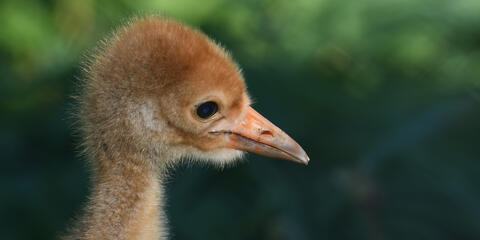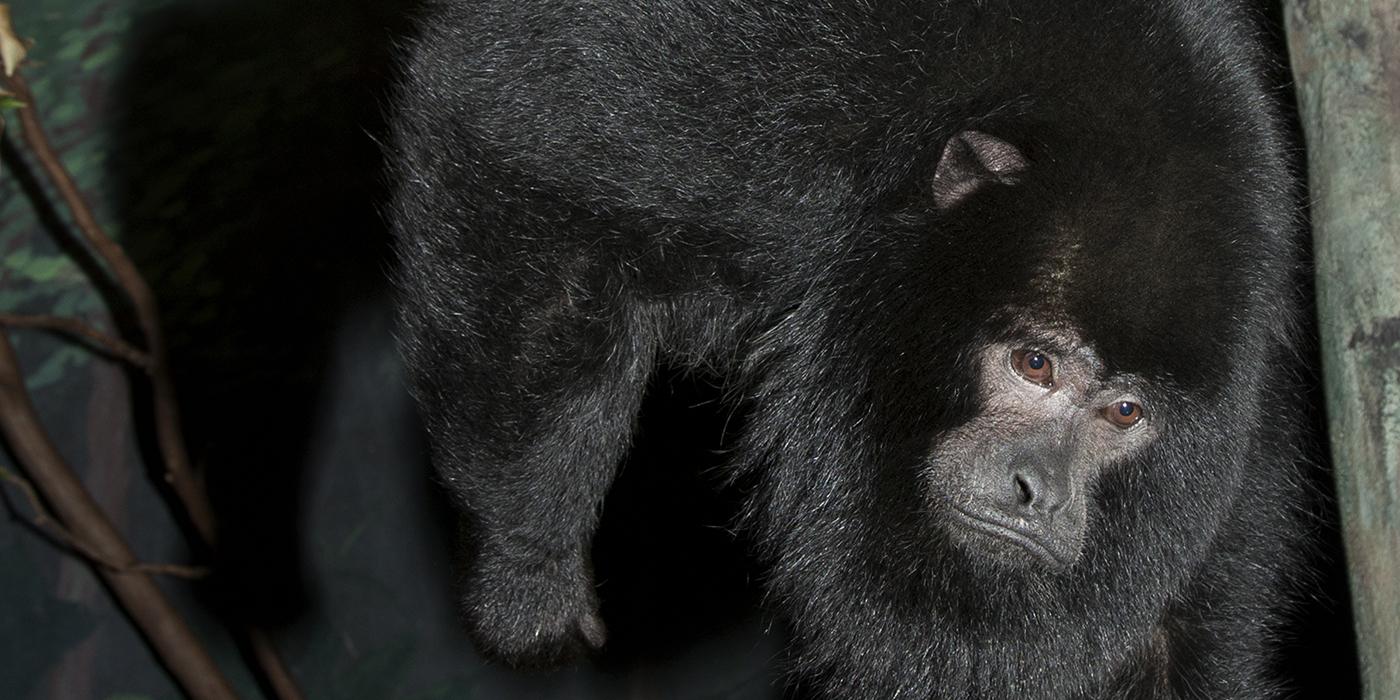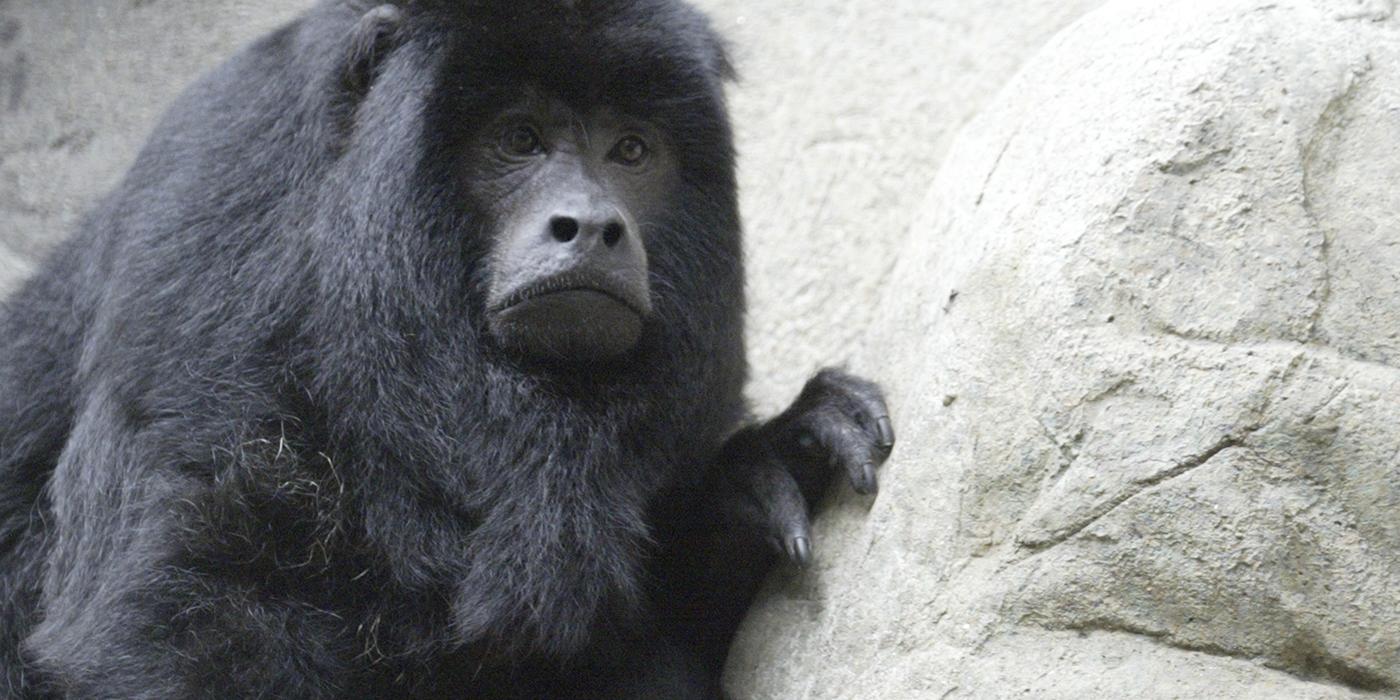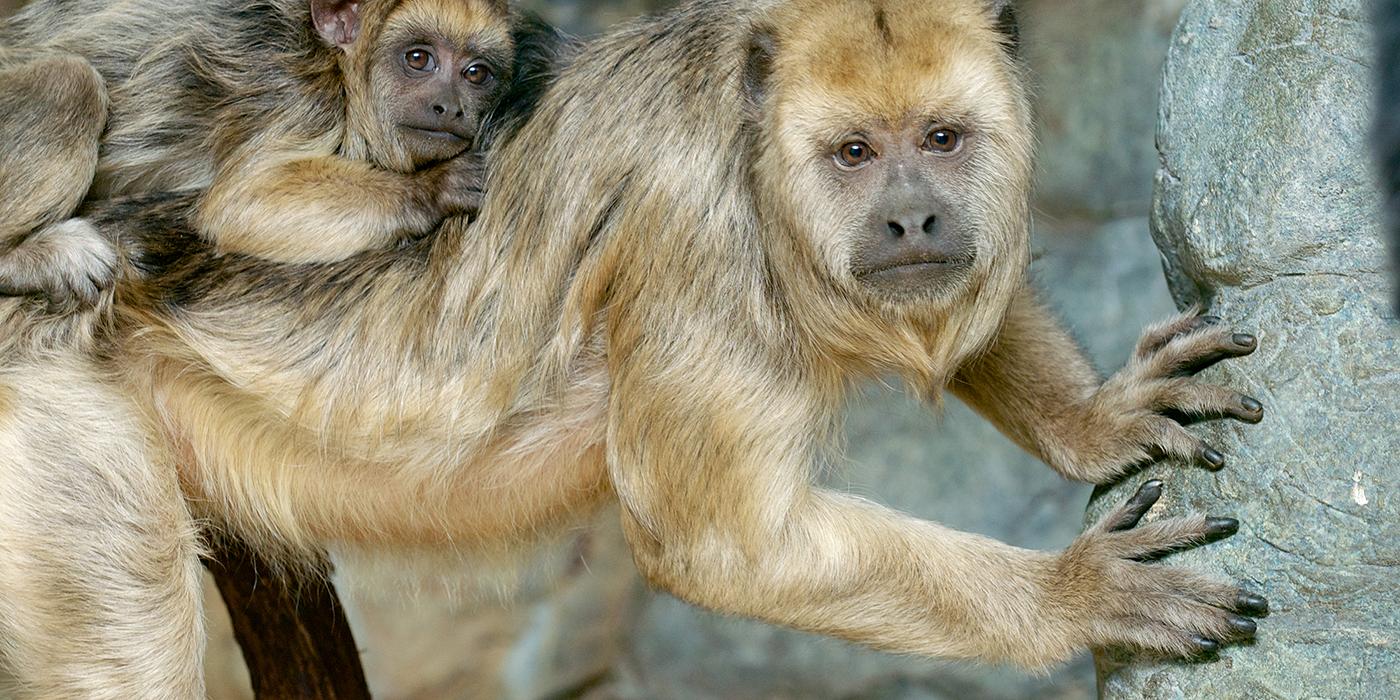Black howler monkeys are the loudest terrestrial animals in the Western Hemisphere! Found in South America, they are usually the largest, most abundant primate in their range. These monkeys are born with blond fur, but the male's fur turns black as they mature.
Physical Description
Black howler monkeys are one of the few primate species with different coat colors in males and females—a trait called sexual dimorphism, which is a broad term that includes differences in size, behavior, and other characteristics between males and females of the same species. Males have a black coat, while females are blonde. Black howler monkeys have a prehensile tail without hair on the bottom side, which they use for grasping during locomotion. The upper molars have sharp, shearing crests that are used in grinding leaves. They move slowly using a quadrupedal mode of locomotion and they have five-toed, grasping feet. The large hyoid bone (Adam's apple) that allows for their loud call restricts arm movement, so howler monkeys rely heavily on their tail for locomotion.
Size
Black howler monkeys are the largest monkeys in Latin American rainforests. Males are much larger than females. Males measure 24 to 26 inches (60 to 65 centimeters) long with a 24 to 26 inch tail (60 to 65 centimeters). Females' bodies are slightly shorter at about 20 inches (50 centimeters). Females typically weigh around 16 pounds (7.3 kilograms), while males weigh around 32.5 pounds (14.8 kilograms).
Native Habitat
Black howler monkeys can be found in southern Brazil, Paraguay, eastern Bolivia, and northern Argentina. They live in primary, arid deciduous, and broadleaf forests.
Lifespan
In the wild, howlers live to be between 15 to 20 years old. In human care they often reach 20 years old.
Communication
The low and guttural sound of howler monkeys is one of the loudest calls produced by any land animal. Under certain conditions, a howler's call can be heard from about 3 miles (4.8 kilometers) away. The male's call is typically louder than the female's and is produced by drawing air through a cavity in an enlarged hyoid bone in the throat, which is larger in males than in females.
Food/Eating Habits
These tree-dwelling herbivores mainly consume tree and vine leaves, flowers and tropical forest fruits. Mammals do not have the enzymes capable of digesting cellulose, the carbohydrate that composes the leaf cell wall. Instead, with the help of bacteria contained in a sacculated stomach, all monkeys in the subfamily Colobinae (e.g. colobus monkeys) receive energy rich gases from the bacteria triggered reaction (fermentation). Unlike colobines, howler monkeys do not have the sacculated stomach, but rather a simple acid stomach that also contains two enlarged sections in the cecum and colon in which fermentative bacteria are found. As with colobines, the gases serve as the energy source. Howlers also eat flowers and fruit, which are far less abundant than leaves and require greater energy expenditure to forage.
They do not need to travel far to find leaves. For this reason, their total home size is about 77 acres (31 hectares) for 15 to 20 animals, and they typically move about 1,300 feet (400 meters) per day. In comparison, a spider monkey, which feeds primarily on fruit, has a home range of 1,000 acres (300 hectares).
At the Smithsonian's National Zoo, they eat primate biscuits, browse, spinach, romaine lettuce, kale, other greens, broccoli, grapes, bananas, apples, melons, carrots, sweet potatoes and green beans.
Sleep Habits
Even with fermentation, howlers can only extract limited calories from their food, so they must be cautious as to how much energy they expend. For this reason they will typically spend half of their waking day resting. Males will settle disputes and defend the group from predators, allowing the females to spend more energy on reproduction and care of the young. As stated earlier, howling functions to help troops space themselves as efficiently as possible, allowing them to overcome the low-energy returns of leaf eating.
Social Structure
Male members of the troop awake each morning and give a dawn "chorus" that is answered by other males. Because howlers do not have an exclusive territory, sharing parts of their home range with others, the morning call and calls that occur when troops move to a new feeding site helps define, defend, and clarify the group's claim on feeding trees in their home range. Weaker troops can identify the location of strong troops and avoid that area, where they would not be able to feed.
When two howler troops do meet, males expend much energy in howling, leaping, running and fighting, which detract from time that could be spent eating or resting. These monkeys howl to let the other groups know where they are, eliminating the energy expenditure needed to patrol territories constantly, or to fight with other troops.
Reproduction and Development
Females generally give birth every two years, resulting in one offspring after a 180-day gestation period. Both sexes are blond until age 2.5, when males turn black. They reach sexual maturity around 18 months. Tongue flicking is a ritualized display of sexual solicitation, with an easily visible pink tongue with black bordering.
Conservation Efforts
These monkeys are hunted for food and used as bait in traps. They are also threatened due to habitat destruction. Agricultural development, particularly for soy and cattle, are the primary drivers of habitat loss. Hunting is for subsistence, and is not in great amounts. Black howler monkeys occur in many protected areas throughout their range.
Help this Species
- Share the story of this animal with others. Simply raising awareness about this species can contribute to its overall protection.
Animal News

Historic Hatching: Northern Shoveler Ducklings





